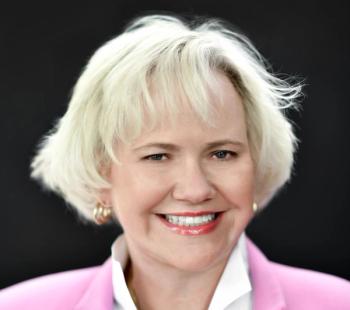
How Sentara Health is reaching underserved communities
The health system has opened clinics and deployed mobile vans to offer better access for patients in Virginia. Sentara leaders talk about the effort and the results they are seeing.
During the COVID-19 pandemic, Dr. Michael Charles says it was clear that patients had glaring health needs that weren’t being addressed.
And that led to the development of Sentara Community Care, a new care model from Sentara Health, a health system serving Virginia and part of North Carolina.
Charles, the executive medical director for Sentara Community Care, said COVID-19 vaccination efforts shed new light on health challenges in many underserved communities, including diabetes, hypertension, and a host of other issues.
“A lot of these communities are struggling and didn’t have access to healthcare,” Charles says. “A lot of the providers had left the area and there wasn't really any place for them to go. So they end up going to the hospital and the ED on a regular basis. So our idea was to put care right into the area where people work, play and worship.”
Over the past two years, Sentara Community Care has brought more care into neighborhoods in need. Sentara has opened five clinics in Norfolk, Richmond, Woodbridge, and Harrisonburg. Sentara has also deployed mobile vans to offer primary care in other communities with limited access to physicians.
Heather Strock, executive director of operations for Sentara Community Care, says the results have been encouraging. Patients are getting more access to care, and that’s diverting some patients from the emergency department for treatment.
Sentara is serving more than 700,000 Medicaid recipients, and Strock says the health system has been listening to community members and faith-based groups about what they need, which she says has been critical. Sentara took those community insights and analyzed data from hospitals, showing people turning to the emergency department for basic care.
“We could see that they were high utilizers of the ER,” Strock says. “They were Medicaid members without care and major gaps in health needs.”
Sentara is planning to open two more clinics this year, and will be adding more mobile vans as well. Sentara has also taken other steps, such as opening a clinic in a homeless shelter, which has helped reduce the number of homeless individuals showing up in the emergency department.
Pediatric needs
Sentara’s clinics and outreach efforts have found a high number of children who hadn’t been getting access to care.
“There's a huge need from a pediatric side,” Charles says.
Sentara’s mobile vans have offered primary care services to kids. Many of the children they have seen haven’t had regular wellness visits.
“We needed to be flexible,” Charles says. “We needed to be mobile. We needed to go to the community, so we couldn't put brick and mortar everywhere.”
Strock says many children they have served aren’t seeing a provider, or they have tried to get access to primary care but have seen long waits. Sentara’s vans are helping offer services for sick kids, but they are also aiming to help connect families to providers to keep them healthy.
Sentara Community Care has also set up clinics in two school districts, and is looking to establish clinics in two other districts this year.
“We’re creating this environment where we can get to students and their families and the faculty in a quicker time for acute needs … But then also connect back to well visits, where we're taking a step and saying, ‘Okay, let us connect you to primary care.’ If it's not us, it's somebody closer to them,” Strock says.
Maternal health
Sentara’s clinicians are also seeing pregnant patients who are in dire need of care.
Charles recalls seeing a woman who was six months into her pregnancy and hadn’t seen a doctor. That patient had two other children, and during those pregnancies, she hadn’t seen a doctor before going to the emergency department when she was in labor.
“A lot of these patients have no prenatal care at all,” Charles says. “And you know, you talk about the challenges we have with maternal mortality rates and disparities with our Black population, with their mortality rates. They're not getting that prenatal care. So there's a huge need for that.”
Patients are getting connected with providers, as well as prenatal vitamins and education on warning signs of complications.
Sentara is also reaching out to rural areas as well. Strock says a Sentara van regularly visits a rural community where the nearby hospital no longer offers a maternity ward.
Sentara’s clinics are seeing patients with a variety of health problems, including diabetes, high blood pressure, heart disease, and emphysema.
Many patients also need behavioral health services.
“We do see a lot of mental health issues,” Charles says. “We see substance use disorder.”
In addition, Sentara has also found patients with dental health needs, and has partnered with a federally qualified health center to support a van to provide dental care in the Hampton Roads region.
‘We’re not leaving’
Sentara has found success in connecting with people at community events. Strock says appearing at community events has been “huge.”
“We didn't realize how important they would be,” Strock says.
Both Strock and Charles repeatedly mention the importance of listening to members of the community about their needs.
“We've learned a lot from our first initial clinic in Norfolk and what the relationship with the community means,” Strock says.
She also stresses the value of transparency, and having a “constant feedback loop” to understand successes and missteps.
“If we mess up, we admit it, and we fix it, and that accountability has built over the last 24 months … building our trust tighter and tighter,” Strock says.
Sentara has been hiring members from the community to work in the clinics and its outreach programs. Strock mentions that has been an important consideration, and community members have said they want to see employees who look like them.
Charles says Sentara is conscious of meeting the expectations of community members and not letting them down. He says it’s important not to make promises that can’t be kept.
He points to both the use of vans to expand access, along with the value of building clinics to show a commitment to those communities.
“We're doing brick and mortar,” Charles says. “We're not leaving. We put some money into this.”






















































































